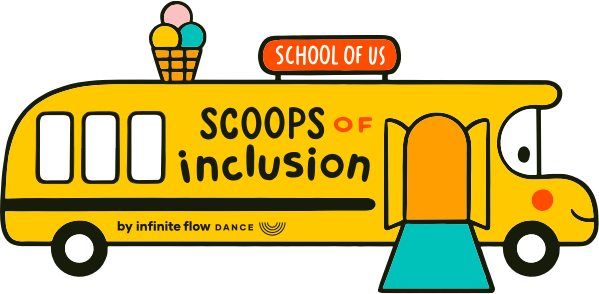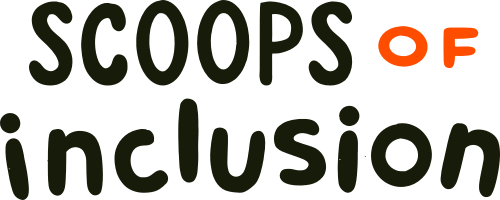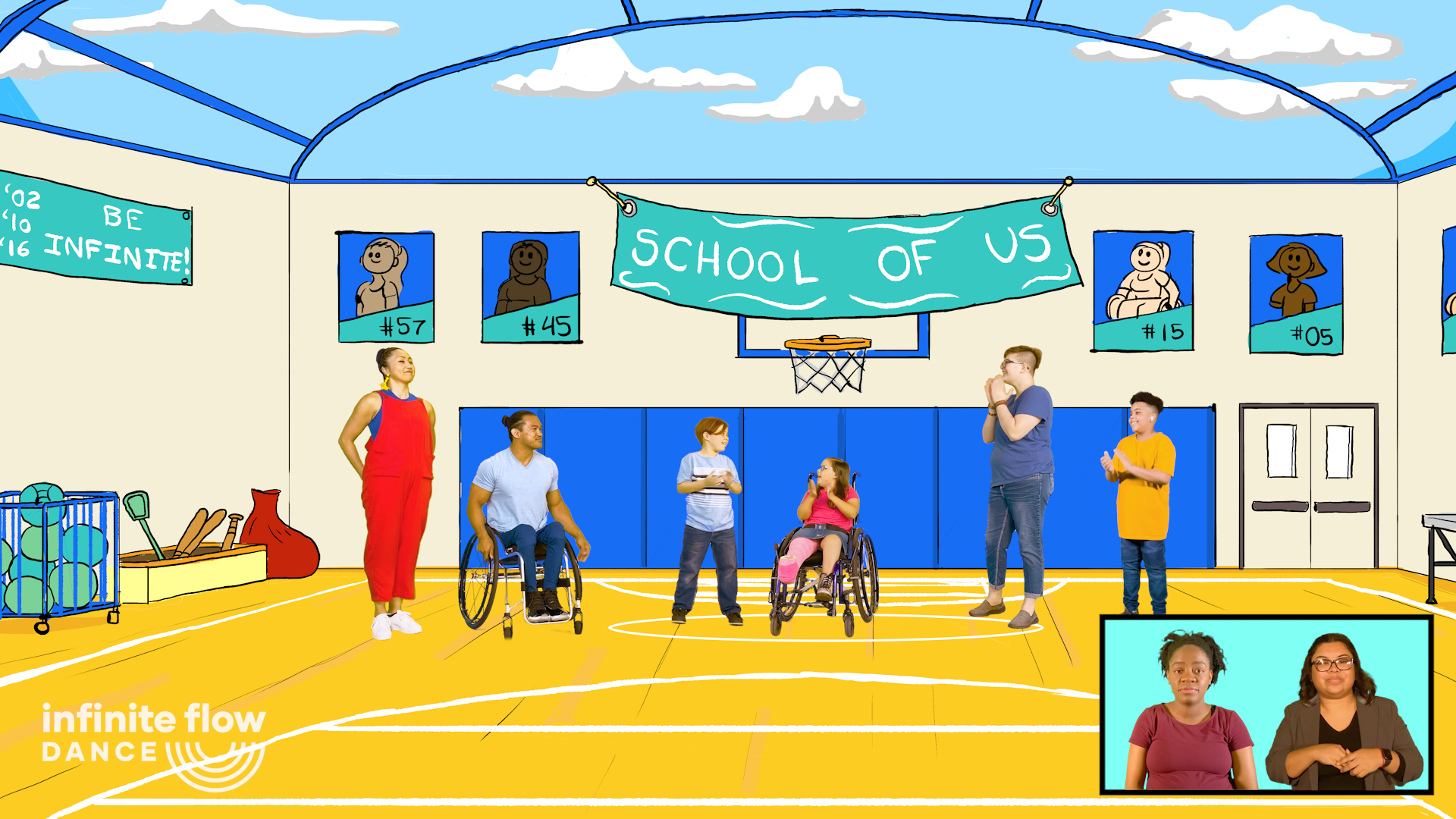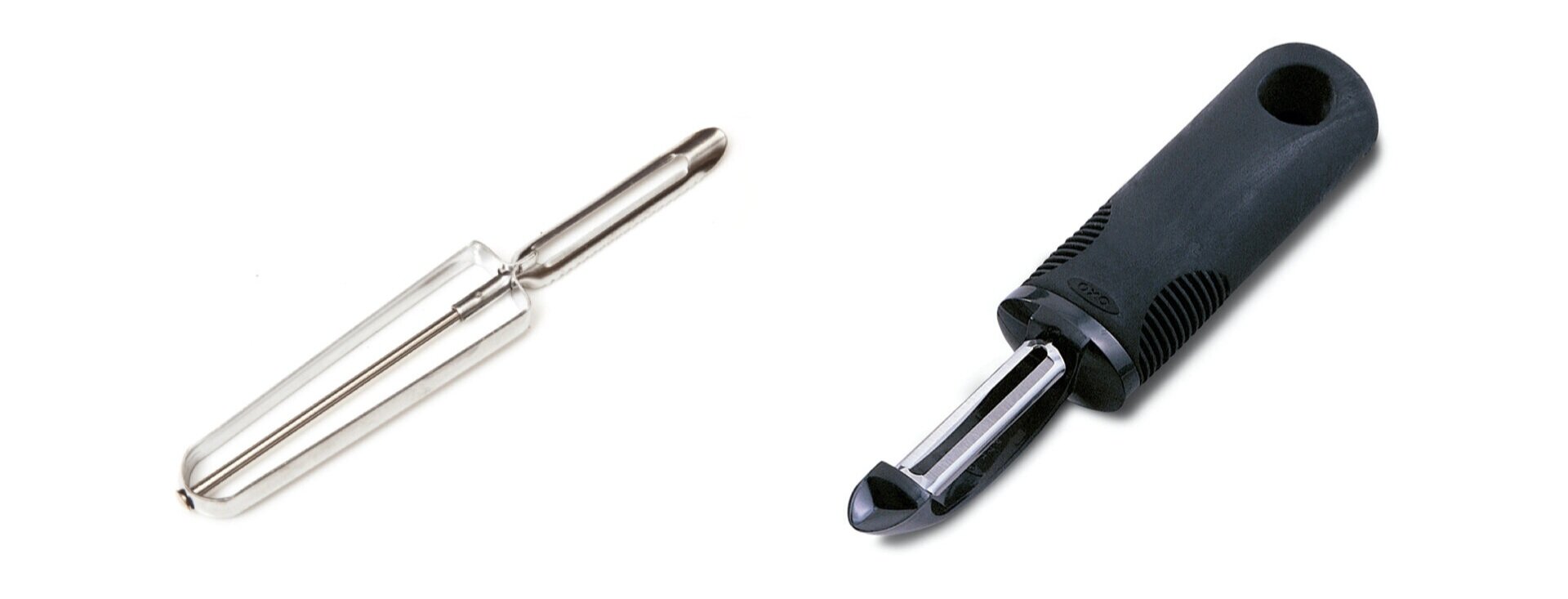Topics In-Depth
+ Discussion Starters
The purpose of this chapter is to give you more context to the film as well as sample discussion starters. Use parts of this chapter to create your own lesson plan and post film discussion. Feel free to create your own discussion starters. We will be adding to this chapter on a weekly basis.
Accessibility Notes
Scene: Front of School
The School Bus with a Ramp
Pronouns
Classroom #1: Adelfo’s Gym
Dismantle the Sad Disability Narrative
Introduction to Accessibility & Accommodations
Call-Out to Schools & Educators
Scoop #1: Be Welcoming to Everyone
Classroom #2: Natalie’s Newspaper Room
Inclusion Inspires Innovation
Disability Etiquette
… content to be added weekly. Stay tuned.
Accessibility Notes
In the first scene of the film, we are introduced to 3 accessibility features: sign language interpretation, captions, and audio description.
Here are some further info on these features.
Sign Language:
Different countries have different sign languages. And even with one spoken language, there maybe different types of sign language. For example, for spoken English, there is American Sign Language (ASL) and British Sign Language (BSL). ASL and BSL are different from each other.
Sign language is a full body expression. It’s a language that not only the hands and fingers, but also uses facial expression and body movement.
Captions:
There is a difference between Closed Captioning and Open Captioning. In Closed Captioning, often labeled as “CC”, an individual can choose to turn on the captions or not. In Open Captioning, captions are seen to everyone. In the Scoops of Inclusion film we use open captioning, so everyone can see the captions during the film.
As Shaheem mentions, captions don’t just help deaf people. Captions can be useful if you use your computer or device without sound, and for visual learners who prefer to read dialogue this could be great too.
Audio Description:
Audio description is a form of narration used to provide information surrounding key visual elements for the benefit of blind and visually impaired people. Imagine watching a movie with your eyes closed. You would probably need someone to explain to you what is going on to understand the plot.
Discussion Starters:
Class + Family: In Scoops of Inclusion we especially hear a lot of description with the duet dances. Go back to the video with Marisa & Adelfo at 04:45 and pay close attention to the audio description. Any discoveries?
Class + Family: Locate the CC button on a Youtube video and practice turning it on and off. How accurate are the captions?
Scene: Front of School - 01:48
The School Bus with a Ramp
At the opening of the film, we see Scarlett and Henry point out that a school bus with a ramp, and that it’s a long bus, not a short bus.
The Backstory:
Piotr Iwanicki, an Infinite Flow dancer who lives between Poland and Los Angeles, is a dancer born with spina bifida who has never had the ability to walk. Piotr uses a wheelchair to get around. Piotr told us that when he was a kid, one day he was waiting for the bus. The bus stopped, saw that he was in a wheelchair, and then left, leaving Piotr behind. Piotr was hurt, and says that the bus driver probably left him there because the bus didn’t have a ramp. Piotr is able to crawl up steps if needed, but the bus driver made the assumption that he is unable to get into the bus.
Nic, one of the youth dancers appearing in the Ice Cream Rap, born with cerebral palsy, and uses a wheelchair to get around, is the only wheelchair user in his class. One time, a field trip got canceled because the teacher found out that the school bus didn’t have a ramp.
Not all school busses have a ramp. And when they do, oftentimes it’s a short school bus, not a long bus. Mia, who appears as the Art Teacher in Scoops of Inclusion, recalls being separated from the rest through being on the short but while her classmates rode on the long bus. She also says that the short bus was considered the bus that the “not so cool kids” rode.
I decided to make the Scoops of Inclusion logo a school bus with a ramp because the ramp is symbolic of the actions we take to create a more inclusive world. We see the “ramp” throughout the film.
The School of Us is radically inclusive that is considered ideal. It is our wish that each school becomes a School of Us.
Discussion Starters:
Class + Family: Should all school busses have a ramp? Why or why not?
Class + Family: Where have you seen a ramp? Are ramps only for wheelchair users? For example, ramps are useful for strollers, carts, wagons, dollies, etc.
Pronouns
River, 17 at the time of shooting Scoops of Inclusion, identifies as “gender fluid”, meaning that their gender fluctuates on a daily basis. River’s preferred pronoun is “they”, not “he” or “she”. River is not the only person who identifies this way. There are many who regard themselves as neither M nor F or regard themselves as both. For more on gender identity and LGBTQ+ topics, see the Coming Out Handbook by the Trevor Project.
Classroom #1: Adelfo’s Gym - 04:25
Introduction to Accessibility + Accommodations
In this scene, we are introduced to the concept of accessibility and accommodations.
Accessibility is the ability to access, specifically for people with disabilities.
Accommodations refer to adjustments made for accessibility, and adjustments made to meet unique needs and circumstances.
Discussion Starters:
Class + Family: Let’s look at wheelchair access. Is your home or building accessible for wheelchair users? Why or why not.
Are there stairs in the entryway? Is there an elevator? Are doorways wide enough for wheelchair and power chair users to fit through?
Class + Family: Accommodations are not limited to adjustments made specifically for people with disabilities such as ramps, sign language, handrails, etc. Accommodations could be anything that makes activities easier. For example, a step stool that you use to reach for your favorite snack in the cupboard or a baby seat in the car. What are some accommodations in your daily life?
Dismantle the Sad Disability Narrative
In this scene, Henry asks Adelfo if he was sad after he found out he couldn’t walk anymore. Adelfo turns the conversation around and asks Henry about a time that he was sad. Henry brings up that he was initially sad when he found out he couldn’t see his friends for a while because of the coronavirus, but eventually figured out how to connect with his friends through video chat and learned to bake with Scarlett, turning a negative situation into a positive. Adelfo’s disability story is similar. Though Adelfo lost his ability to walk, he found new ways to do the things he loves to do. Loss is something we all experience at some point in our lives. However, people with disabilities are oftentimes seen as sad victims.
That said, we want to avoid these mindsets
Charity Mindset: Thinking of people with disabilities as victims who need help and support from others in order to thrive. While the intention behind being “charitable” is not inherently wrong, it runs the risk of taking away a person’s autonomy and independence.
Savior Complex: This is when someone takes on the role of “saving” another person from whatever their situation is. In a school setting, it can look like the teacher going above and beyond to make things easier for a student with a disability, instead of simply giving them the accommodations they need while maintaining high expectations.
Discussion Starters:
Class/Family: Describe Adelfo. What does he look like? What do you know about him? What do you want to know more about him? Would you want to take gym class with Adelfo?
Call-Out to Schools & Educators
Scarlett and Henry are real-life 9-year-old twins in 4th grade at the time of shooting Scoops of Inclusion. In the film, we hear that they have changed schools 8 times and that the School of Us is the 9th school. In real-life, they have changed schools 3 times and are at their 4th school. One reason why they have changed schools so many times is that the twins were not able to partake in activities together. In this scene Adelfo assures the twins that they will be able to take gym class together.
Review your class and school operations. Are there any activities where students with disabilities, ESL, and other needs are taken out of class, and separated or excluded from the rest of their class? Have you ever asked how these students feel about this? We challenge you take a close look at this.
Scoop #1: Be welcoming to everyone - 10:41
Be Welcoming to Everyone
Marisa’s Scoop Script:
Be welcoming to everyone, making sure no one is left out. In this previous scene, we saw that the original location to the Ice Cream Extravaganza was not in a welcoming place for wheelchair users. So, it got moved to the gym. Next time you plan a party, make sure you ask your guests if they need anything.
Discussion Starters:
Classroom: Let’s plan a class ice cream party. What are some things we need to take into consideration so everyone can enjoy ice cream together?
Family: Let’s plan for a birthday party. What’s the theme? What are some things we need to take into consideration so everyone can enjoy the party?
How this whole ice cream concept came about
Inclusion is a concept that is not so easily defined. As we went out to schools, I found it challenging to explain inclusion in a kid-friendly way.
In spring 2019 I had an opportunity to speak and perform at an all-girls school in Washington DC. For this speaking engagement, I prepared a few talking points but didn’t memorize my speech word by word and decided to be spontaneous. In the midst of sharing about Infinite Flow, I ended up asking the students to raise their hands if anyone was lactose intolerant, or vegan, or had other dietary restrictions. Surely many hands went up. I then made the analogy of planning a welcoming ice cream party to being an inclusive leader. Then it hit me, that’s it, we can use planning an awesome ice cream party as a way to explain inclusion.
Accessibility and inclusion work like a good ice cream party where everyone can enjoy ice cream together. You don’t have to be an inclusion expert to create an environment where everyone feels they belong. Put yourself in the shoes of a person with a disability or someone who requires a unique accommodation. How would you feel being left out? It starts with having the heart to recognize and care about other people’s experiences, then leading with that heart.
Classroom #2: Natalie’s Newspaper Club - 11:46
Inclusion Inspires Innovation
In this scene, Natalie and Forrest introduce us to the origin story of the typewriter, where the typewriter was invented as a result of a blind woman wanting to write a love letter. As a result of designing from disability, out came an invention that revolutionized the world. Designing from disability benefits all of us, and inclusion inspires innovation.
Starting with the typewriter, here are a gadgets invented from disability:
Invention #1: The Typewriter and Keyboard
In the early 1800s, a woman by the name of Countess Carolina Fantoni da Fivizzano was losing her vision at a time when the only way to write a letter, as if she dictated her words verbally, and someone else transcribed it. But, if it’s a love letter, you definitely didn’t want anyone else to overhear your words. The Countess was friends, and according to some sources a lover of Italian inventor Pellegrino Turri. Together they developed a machine, that became the first iteration of the typewriter, which has evolved over time into the modern keyboard.
Invention #2: OXO Peeler
While vacationing in a rented home in southern France in the 1980s, Sam Farber saw his wife Betsey have trouble using her metal peeler to peel apples due to arthritis. This eventually led Sam to create OXO, a new product line of kitchen utensils fitted with soft plastic-coated black handles, which made them easier to hold and use. OXO kitchen utensils are used by millions around the world.
Invention #3: Email
Vinton Cerf, one of the “fathers of the internet” was born deaf, and married Sigrid, who was also deaf. Along the path of finding a way to communicate with his wife when they were not in the same room, he ended up inventing Email.
Invention #4: The Segway
This trending Segway was developed from the iBOT wheelchair, a motorized wheelchair that can balance on two wheels, tackle snow, sand, terrain, and most notably, climb and descend stairs. The iBOT was first revealed in 1999 on CNBC and was developed by Dean Kamen in a partnership with his company DEKA and Johnson and Johnson.
Invention #5: The Touch Screen
Wayne Westerman had carpal tunnel syndrome and wanted to find a way to interact with his computer that required no force in the hand. This eventually led him to invent the touch screen. Westerman then sold it to Apple in 2005, which enabled Apple to build the first iPhone. The rest is history.
Our Approach at Infinite Flow Dance
At Infinite Flow, “Inclusion Inspires Innovation” is one of our tag lines. As the Artistic Director, I’m always on an exploration of innovating from a perceived limitation. Check out this video, and you’ll see what I mean.
Discussion Starters:
Class + Family: Which of these innovations are you most surprised to hear that they came from designing from disability?
Class + Family: How can we repeat this process? What would the world look like if we placed accessibility and disability inclusion first, not last?
References:
Mismatch: How Inclusion Shapes Design by Kat Holmes
https://www.fastcompany.com/90239156/the-untold-story-of-the-vegetable-peeler-that-changed-the-world
https://en.wikipedia.org/wiki/Sam_Farber
https://en.wikipedia.org/wiki/Segway
https://www.newmobility.com/2019/07/the-ibot-is-back/
Accessible Technology
Natalie also introduces us to accessible technology by sharing how she reads with a screenreader and writes with voice recognition. Here are a couple more videos
Discussion Starters:
Explore the accessibility features on your computer and devices. What kind of features are these? Why are these features important?
Reference Links:
Disability Etiquette
In this scene, we are introduced to disability etiquette. Scarlett mentions that she doesn’t like it when people push her wheelchair and Natalie mentions that sometimes kids are mean by asking her how many fingers they are holding up, even though they know that she can’t see.
Here are more examples of common disability etiquette;
Speak directly with the person with a disability.
Ask before you help.
Avoid touching medical equipment or guide dogs.
Don’t talk to a person with a disability anything differently from someone else. Disability is just a characteristic.
For a more comprehensive overview, check out United Spinal Disability Etiquette
Alongside disability etiquette is inclusive language. We don’t go into the discussion of inclusive language too much in the film, but here are some best practices.
Inclusive Language
Place people first: When for addressing disability or chronic illnesses, place the person first. For example, use “person with a disability” vs “a disabled person”. For more info visit Office of Disability Rights People First Language
Avoid mental illness and disability as metaphors: “Bipolar”, “OCD”, “ADD”, “PTSD”, “retardation” and “paralysis” are real psychiatric and cognitive disabilities. Being a stroke survivor who had been temporarily paralyzed from the neck down, whenever I hear something like “The exam was so difficult, it was paralyzing”, I cringe. And having been through PTSD as a sexual assault survivor, names of mental illnesses are not to be used lightly.
Avoid using “them” and “they” when addressing people with disabilities. By using “them” and “they”, you are separating people with disabilities from the rest of the population. Inclusion is about us, not “them”™
Avoid making assumptions on disability diagnosis. Some disabilities are invisible and someone using a wheelchair may be from a temporary injury.
Discussion Starters:
Class/Family: What are some things you are going to be mindful of next time you meet someone with a disability?
Scoop #2: Be an ally.
Marisa’s Scoop Script: An ally is someone who makes sure everyone is treated fairly. Sometimes you may be an ally, and at other times someone else may become an ally to you. You never know when you might be in an unfair situation, so it’s important we all take turns supporting each other.
Part of allyship is listening to other’s stories and struggles, being empathetic, and being by their side. This beautiful video by Netflix illustrates this well.
Discussion Starters:
Class/Family: When is a time you’ve been an ally? When is a time that you’ve been an ally to others?
More content and discussion starters to be added. Stay tuned.
Contents
We recommend going through the guide in the order below.
Contact:
info@infiniteflowdance.org
NOTE from Infinite Flow HQ: We are a slim team with no one working full time. We will spend an average 1 hour per weekday on customer service and answering emails. Should an answer be found in the guide, we will simply ask you to refer to the guide, so we ask that you read the guide in full. This guide will be updated in realtime on this website. Thank you for your cooperation.











